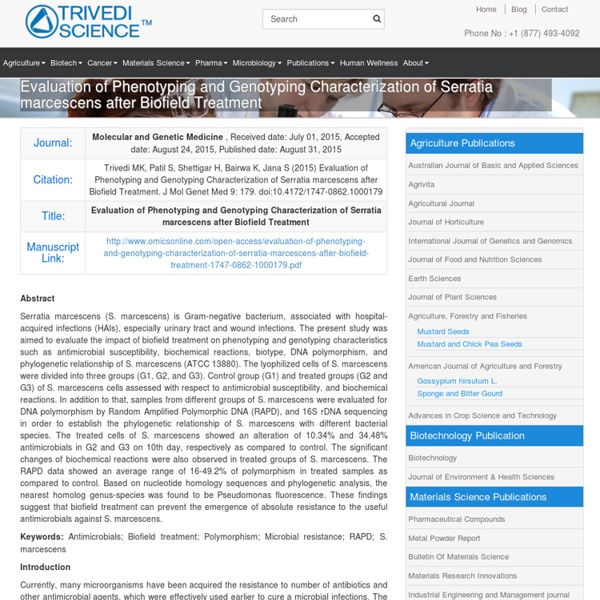



Biotyping of Enteropathogenic MDR Escherichia coli Isolates Description Study background: Multidrug resistant Escherichia coli (MDR E. coli) has become a major health concern, and failure of treatment leads to huge health burden. Aim of the present study was to determine the impact of Mr. Trivedi’s biofield treatment on E. coli. Methods: Four MDR clinical lab isolates (LSs) of E. coli (LS 8, LS 9, LS 10, and LS 11) were taken and divided into two groups i.e. control and biofield treated. Research on Escherichia Coli Biochemical Characteristics Bioeld as an energy medicine has been included in complementary and alternative medicine (CAM) therapies, and very commonly practiced in US by professional healthcare representative [11]. CAM
Multidrug Resistant Isolates of Pseudomonas Aeruginosa Abstract In recent years, prevalence of multidrug resistance (MDR) in Pseudomonas aeruginosa (P. aeruginosa) has been noticed with high morbidity and mortality. Aim of the present study was to determine the impact of Mr. Trivedi’s biofield treatment on MDR clinical lab isolates (LS) of P. aeruginosa. Five MDR clinical lab isolates (LS 22, LS 23, LS 38, LS 47, and LS 58) of P. aeruginosa were taken and divided into two groups i.e. control and biofield treated.
Evaluation of Phenotype and Genotype of Enterobacter Aerogenes Abstract Enterobacter aerogenes (E. aerogenes) has been commonly described as a versatile opportunistic pathogen in hospital infections. The aim of the present work was to evaluate the impact of biofield treatment on E. aerogenes for its phenotypic and genotypic characteristics. Experimental results of Escherichia Coli Antibiotic Sensitivity Assay Study background: Multidrug resistant Escherichia coli (MDR E. coli) has become a major health concern, and failure of treatment leads to huge health burden. Aim of the present study was to determine the impact of Mr. Trivedi’s biofield treatment on E. coli. Methods: Four MDR clinical lab isolates (LSs) of E. coli (LS 8, LS 9, LS 10, and LS 11) were taken and divided into two groups i.e. control and biofield treated. Control and treated samples were identified with respect to its antimicrobial sensitivity assay, biochemical study and biotype number using MicroScan Walk-Away® system. The analysis was done on day 10 after biofield treatment and compared with its respective control group.
Human Energy Impact on Thermal Properties of DHBP Citation: Trivedi MK, Tallapragada RM, Branton A, Trivedi D, Nayak G, et al. (2015) Physical, Thermal and Spectral Properties of Bioeld Energy Treated 2,4-Dihydroxybenzophenone. Clin Pharmacol Biopharm 4: 145. doi:10.4172/2167-065X.1000145 Antimicrobial Sensitivity of Staphylococcus Saprophyticus Abstract Staphylococcus saprophyticus (S. saprophyticus) is a frequent cause of urinary tract infection in the young women. The current study was designed to analyze the effect of biofield energy treatment on S. saprophyticus for evaluation of its antibiogram profile, biochemical reactions pattern and biotyping characteristics. Two sets of ATCC samples were taken in this experiment and denoted as A and B.
Potential Impact of Biofield on HIV Viral Load Test Abstract Viral load quantification is the amount of particular viral DNA or RNA in a blood samples. It is one of the surrogate biomarker of AIDS. Thermal Properties of DHBP after the Human Energy Treatment Description Study background: 2,4-Dihydroxybenzophenone (DHBP) is an organic compound used for the synthesis of pharmaceutical agents. The objective of this study was to investigate the influence of biofield energy treatment on the physical, thermal and spectral properties of DHBP.
TGA Analysis of Biofield Treated 2,4-Dihydroxybenzophenone Study background: 2,4-Dihydroxybenzophenone (DHBP) is an organic compound used for the synthesis of pharmaceutical agents. The objective of this study was to investigate the influence of biofield energy treatment on the physical, thermal and spectral properties of DHBP. The study was performed in two groups (control and treated). The control group remained as untreated, and the treated group received Mr. Trivedi’s biofield energy treatment. Analysis of Multidrug Resistant S.Maltophilia Abstract Stenotrophomonas maltophilia ( S. maltophilia ) is a Gram-negative bacillus, an opportunistic pathogen, particularly among nosocomial infections. Multi-drug resistant strains are associated with very high rate of morbidity and mortality in severely immunocompromised patients. Present study was designed to evaluate the effect of biofield treatment against multidrug resistant S. maltophilia .
Investigation of antimicrobial susceptibility of E. cloacae Abstract Soybean production in Iowa USA is among the most productive for raínfed regions in the world. Despite generally having excellent soils, growing season temperatures and rainfall, soybean yields are decreased by weed interference and inadequate available soil water at key stages of crop development. A field study was conducted at two locations in lowa in 2012 to determine if seed-applied fungicide or biofield treatments influenced weed community, soil volumetric water concentration and soybean yield and quality. Application of biofield treatment resulted in lower density of tall waterhemp density, greater soybean stand density at R8 stage and greater seed pod-1 compared to the absence of seed fungicide and biofield Soil volumetric water content varied by seed fungicide x biofield x date interaction but differences were not consistent among treatment combinations.
Menthol TGA Analysis - Evaluation of Energy Medicine Description Thymol and menthol are naturally occurring plant derived compounds, which have excellent pharmaceutical and antimicrobial applications. The aim of this work was to evaluate the impact of biofield energy on physical and structural characteristics of thymol and menthol. The control and biofield treated compounds (thymol and menthol) were characterized by X-ray diffraction (XRD), Differential Scanning Calorimetry (DSC), Thermogravimetric analysis (TGA), and Fourier Transform Infrared Spectroscopy (FT-IR). XRD study revealed increase in intensity of the XRD peaks of treated thymol, which was correlated to high crystallinity of the treated sample.